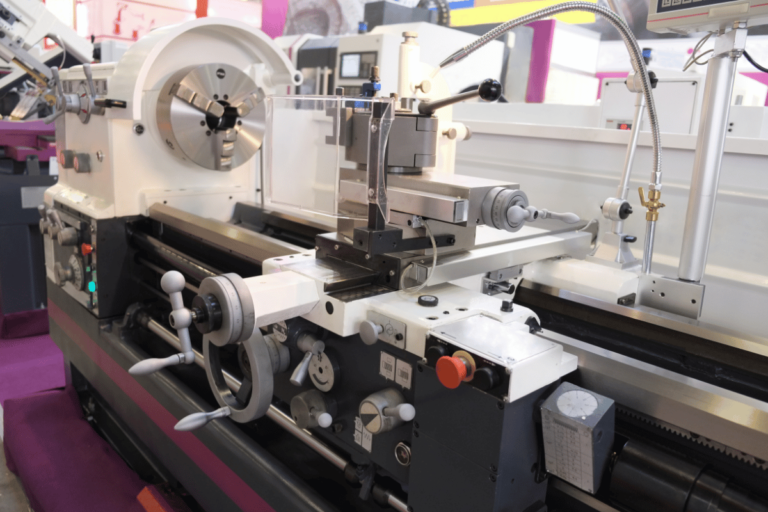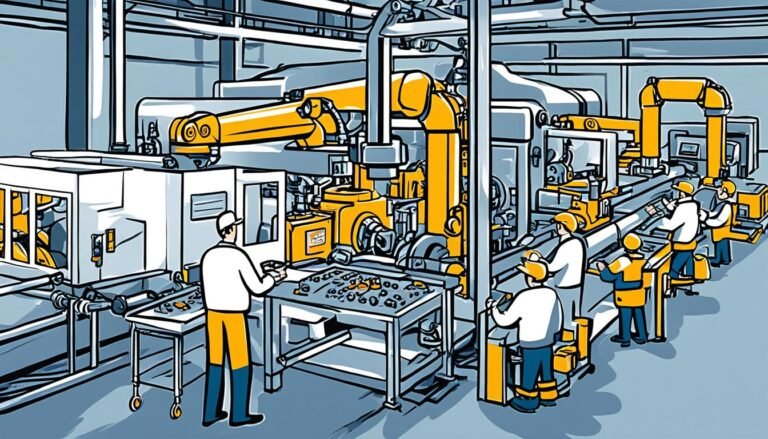Applying PDCA (Plan-Do-Check-Act) in Manufacturing
Did you know that using the PDCA cycle can cut down on welding defects by over 20%? This shows how powerful the PDCA method is for ongoing improvement and quality management. It started in the 1920s by Walter A. Shewhart and was later expanded by W. Edwards Deming. Now, it’s a key part of making manufacturing lean and efficient.
In manufacturing, issues like solder bridges, missing parts, and not enough soldering happen often. The PDCA cycle helps fix these problems by focusing on quality and efficiency. Its four steps – Plan, Do, Check, Act – let manufacturers test improvements, see how they work, and spread successful ideas. This cycle not only improves quality but also increases how much can be made by 20%.
Key Takeaways
- The PDCA cycle is key for ongoing improvement and quality management.
- Walter A. Shewhart and W. Edwards Deming developed the PDCA cycle, which supports Lean manufacturing.
- Using PDCA can cut welding defects by over 20% and boost production by the same amount.
- PDCA has four steps: Plan, Do, Check, Act, aimed at continuous improvement.
- Big companies like Nike and Nestlé have seen great success with PDCA in making their processes better.
Introduction to the PDCA Cycle
The PDCA cycle, also known as the Shewhart Cycle or Deming Cycle, is key for making changes and improving processes. It has four steps: planning, doing, checking, and acting. These steps help with ongoing improvement and better quality management in manufacturing.
Walter Shewhart, known as the father of statistical quality control, first introduced the PDCA method. Later, William Deming added the important steps of design, make, sell, and test. In 1951, the Japanese Union of Scientists and Engineers (JUSE) made the cycle what we use today. It’s a big part of lean project management in manufacturing.
- The Plan stage is where you identify problems, set goals, and make a plan to reach them.
- In the Do stage, you put the plan into action on a small scale to see if it works.
- The Check stage is about watching and judging the results against the goals set in the Plan stage.
- Finally, the Act stage is for making the successful parts standard and putting them into wider use, or fixing any problems.
The PDCA cycle is great for making things better over time because it’s structured and disciplined. It’s not just for manufacturing; it can be used in many industries to solve problems and keep improvements going.
Using this cycle means combining the best practices at every stage. You need a strong plan, careful execution, detailed analysis, and effective changes. This cycle helps keep improving quality management and makes organizations more efficient.
Below is a table summarizing the four stages of the PDCA Cycle:
| Stage | Description | Purpose |
|---|---|---|
| Plan | Define the problem and develop a strategy | Establish clear objectives and strategies |
| Do | Implement the strategy on a small scale | Test the feasibility of the plan |
| Check | Analyze the outcomes | Compare results against expectations |
| Act | Implement changes based on findings | Standardize successful strategies |
History and Development of the PDCA Cycle
The PDCA (Plan-Do-Check-Act) cycle is key to Lean Manufacturing and Total Quality Management (TQM). It started in the early 1900s and has changed how the world makes things. It made Japanese manufacturing more efficient.
Origin by Walter A. Shewhart
Walter A. Shewhart, an American expert in statistics, physics, and engineering, created the PDCA cycle in the 1920s. His idea was a three-step process for better quality and improvement. Over time, it grew into the PDCA cycle we know today.
This cycle brought a scientific way to solve problems and improve quality. It helped set the stage for Total Quality Management (TQM).
Expansion by W. Edwards Deming
W. Edwards Deming didn’t start the PDCA cycle, but he made it bigger. He added it to his Total Quality Management (TQM) ideas. Deming took this cycle to post-war Japan, where it helped the industry grow.
This four-step model—Plan, Do, Check, Act—focused on constant improvement. It led to better quality and efficiency in Japanese manufacturing.
The PDCA cycle’s impact goes beyond Japan. It’s now a worldwide way to improve quality and efficiency in many industries.
| Date | Contributor | Contribution |
|---|---|---|
| 1920s | Walter A. Shewhart | Developed the original three-step cycle |
| 1940s | W. Edwards Deming | Enhanced and popularized the PDCA cycle |
| 1950s | Japanese Manufacturing | Adopted PDCA for industrial efficiency |
The PDCA cycle’s story from its start to being known worldwide shows the power of continuous improvement. It’s thanks to visionaries like Walter A. Shewhart and W. Edwards Deming.
Steps in Applying PDCA (Plan-Do-Check-Act) in Manufacturing
Using PDCA in manufacturing means following four steps: planning to spot and solve problems, doing small-scale changes, checking how they work, and acting to make them standard. This method helps keep the manufacturing sector always getting better.
Plan
The first step is planning. It’s key to find out what problems exist and why they happen. Tools like the 5 Whys help with this. Setting clear goals, like making a new bolt supplier work in Guangdong, China, within 30 days, is important.
Knowing the problem well is the base for using PDCA right.
Do
Then, it’s time to make small changes. These pilot projects let us test new ideas safely. Collecting data during this phase helps make decisions based on facts. Pilot projects help improve processes and make sure changes work well.
Check
The ‘Check’ phase looks at how the first changes worked. It’s important to see if the changes improved things as hoped. This step helps figure out if more changes are needed.
Many companies find this step hard, which can stop them from getting the results they want.
Act
The last step is making sure good strategies are used everywhere. This phase makes sure new improvements are part of everyday work. Standardizing changes in this phase makes sure they’re always done right, promoting ongoing improvement.
This step helps avoid wasting time on changes that don’t work and boosts results.
Best Practices for Effective PDCA Implementation
Using the PDCA cycle is key to improving business processes. To make sure it works well, follow best practices that boost results and keep things consistent. Here are some important strategies:
- Set SMART Goals: A strong PDCA cycle starts with good planning. Setting smart goals (Specific, Measurable, Achievable, Relevant, and Time-bound) gives clear direction. It helps use resources well and track progress.
- Conduct a Root Cause Analysis: Finding the real cause of problems is vital. Using root cause analysis helps solve problems right in the “Check” phase. This way, we fix the real issues, not just the symptoms.
- Utilize Digital Knowledge Management Tools: For sharing and keeping track of information, use digital Knowledge Management tools. These tools make it easy to share knowledge, making decisions better and keeping everyone informed.
- Engage Employees: Getting employees involved is key to PDCA success. By including them, we get different ideas, build ownership, and improve together.
- Implement Small-Scale Changes: Start with small changes to manage risks in the “Do” phase. Analyzing data in real-time helps make better decisions, making future actions more accurate.
- Standardize Successful Methods: Once we find what works, make it a standard in the “Act” phase. This keeps things running smoothly and makes sure good practices become part of the company culture.
Using these best practices in the PDCA cycle brings big results across many industries. Whether it’s manufacturing, healthcare, IT, or services, using PDCA fully can lead to continuous improvement, better problem-solving, and happier customers.
| Industry | Benefits of PDCA Cycle |
|---|---|
| Manufacturing | Optimized production processes, improved product quality, reduced defects, decreased delivery times |
| Healthcare | Enhanced patient care, streamlined administrative processes, improved healthcare quality |
| Information Technology | Efficient software development, effective network management, improved IT service delivery |
| Service Industries | Enhanced customer service, reduced errors, increased efficiency |
By following the PDCA method with these best practices, organizations can reach top performance and keep growing.
Real-Life Examples: Success Stories of PDCA in Manufacturing
The PDCA (Plan-Do-Check-Act) cycle is key to lean thinking and ongoing improvement. It has helped many industries, especially manufacturing, succeed.
Nestlé
Nestlé shows its dedication to getting better with the PDCA cycle. Through Nestlé lean management, it has cut waste and made processes more efficient. Value Stream Mapping helped spot and fix problems, making things run smoother.
This methodical use of PDCA has led to big wins for Nestlé. The company keeps checking and tweaking its steps. This keeps it ahead in the global market.
Lockheed Martin
Lockheed Martin, a leader in aerospace, uses PDCA for better quality and efficiency. By applying PDCA, they’ve made big strides. For example, they cut manufacturing time by 38% over five years.
PDCA has been crucial for Lockheed Martin’s success. It helps solve problems and make processes better. Lockheed Martin shows how PDCA can change complex manufacturing for the better.
| Company | Focus Area | Result |
|---|---|---|
| Nestlé | Lean Management | Increased Efficiency, Waste Reduction |
| Lockheed Martin | Aerospace Efficiency | 38% Reduction in Manufacturing Time |
Conclusion
The PDCA (Plan-Do-Check-Act) cycle is key to improving quality in manufacturing. It started with Walter Shewhart in 1929 and was made more popular by W. Edwards Deming in the 1950s. This simple yet powerful model helps manufacturers improve, make better products, and cut waste.
This cycle helps improve processes over time. It lets companies test small changes before making big ones. This way, they can fix problems early and make sure their processes are the same everywhere. It makes teams work better together, solving problems and coming up with new ideas.
Using PDCA in manufacturing creates a culture of always getting better. It’s used in many fields, from healthcare to Lean Management. By using PDCA every day, companies can get better at what they do. This leads to a lasting commitment to being the best and staying ahead of the competition.
Source Links
- Applying the Plan-Do-Check-Act (PDCA) Cycle to Reduce the Defects in the Manufacturing Industry. A Case Study
- What Is the Plan-Do-Check-Act (PDCA) Cycle? +Examples
- What Is the PDCA Cycle in Manufacturing?
- The PDCA Cycle: A Practical Approach to Problem-Solving
- What is the Plan-Do-Check-Act (PDCA) Cycle? [2024] • Asana
- How to Apply the Plan-Do-Check-Act (PDCA) Model
- Plan Do Check Act – Implementing PDCA in Manufacturing
- How to Implement the PDCA Cycle (Plan-Do-Check-Act) [Free Template]
- How to Apply the PDCA (Plan, Do, Check, Act) Model | Thogus
- PDCA Method: A Complete Guide to Lean
- Understanding the Plan-Do-Check-Act (PDCA) Cycle | Mailchimp
- PDCA is How We Improve the Industry
- What is PDCA? (and Why It Matters for Marketers)
- Business Enterprise Mapping | BEM Insights
- What is Plan Do Check Act? How to Apply the PDCA Model







